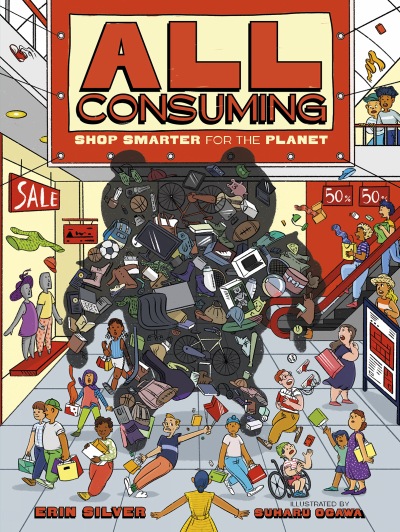All Consuming: Shop Smarter for the Planet

All Consuming: Shop Smarter for the Planet
Have you ever heard of retail therapy? It’s the rush of joy you get from buying something new, especially on a day that hasn’t gone your way. Those happy feelings soar when your friends compliment you on your cool new sneakers or your shirt. Unfortunately, the great feeling we get from shopping tends to last about three wears, or maybe even one month, before those new items seem old. Then we cast them aside and go back to the mall or shop online for more. Much more.” (p. 5)
Although you may have books making the connection between consumerism and its impact on the environment, do you have one packed with up-to-date, relevant Canadian data and examples? If not, All Consuming: Shop Smarter for the Planet needs to be on your next purchase list.
Organizing the book into four chapters, author Erin Silver looks carefully at the choices we make about purchasing clothes, food, technology, and gifts. Each chapter is subdivided with sections that examine the historical context so that readers understand how we got to where we are; continues with an exploration of the costs to the environment of the decisions we make; and ends with ideas for actions to make more sustainable choices.
For example, “Chapter One: Cheap and Chic T-shirts” looks first at the exploitation of workers, including children, in fashion industry sweatshops. And then second, it considers the environment, the other “Fashion Victim”.
If global shopping habits continue to grow, clothes could be responsible for generating 26 percent of carbon emissions by 2050, instead of about 10 percent today. These figures don’t even include the environmental damage caused when clothes are dyed, made, shipped, delivered, bought, washed or thrown away. (p. 12)
The final section in each chapter looks at ways to lessen the impact of our consumer choices on the planet.
“Chapter One: Cheap and Chic T-shirts” concludes with the topics “Taking Action”, “Fashion Forward”, and “How to Shop Sustainably”.
“Chapter Two: Would You Like Fries With That?” ends with “On the Menu…Sustainable Solutions You Can Try at Home”.
“Chapter Three: You Used To Call Me” includes “Solutions around the World” and “Here’s How Kids and Organizations Are Helping”.
“Chapter Four: Gifts Galore” ends with a call to “Use Your Power Wisely”.
Buying only sustainable products is a big goal. It will take time to change our shopping patterns. But small changes to your buying habits and what you choose to buy or not buy can make a big difference. Doing simple things like keeping your phone a little longer, giving thoughtful homemade gifts, refusing single-use plastics at restaurants and thinking about clothing purchases will help people and the planet. (p. 76)
Illustrator Suharu Ogawa hits just the right tone in her colourful representations of young people acquiring and discarding consumable items at a hectic pace. Photos, maps, charts, and sidebars all add to the visual appeal of All Consuming: Shop Smart for the Planet.
The issues addressed in this book are global, and examples of good and bad practices from around the world are liberally spread through all four chapters. Many of the suggestions for actions are practical micro-actions, things that young readers can do on their own or as part of local initiatives. Many of those examples and suggested actions are Canadian.
Tentree, a clothing company based in Regina, Saskatchewan, plants 10 trees for every garment it produces. Its goal is to plant one billion trees in communities around the world by 2030. Not only do trees absorb CO2 from the air, but they also restore habitat for wildlife. Tentree makes clothes in a way that leaves the smallest possible footprint. Its sweatshirts, for example, are made using 75 percent less water than any other hoodie in your closet. The company also creates circular supply chains by reusing leftover materials to make other products. (p18)
The Advanced Reading Copy of “All Consuming: Shop Smart for the Planet” that this review is based on includes a three-page glossary, a “Resources” section with Print and Websites, many of which are Canadian, and a blank “Index”. The Index will be completed in the final copy.
All Consuming: Shop Smart for the Planet is a useful and engaging source of both global and local information and resources. Unless you already have an excess of grade appropriate consumer material with Canadian data and references, you will want to add this title to your library or school resources as soon as possible.
Suzanne Pierson, a retired teacher librarian and former library course instructor, tends her Little Free Library in Prince Edward County, Ontario, for the enjoyment of her friends and neighbours of all ages.
